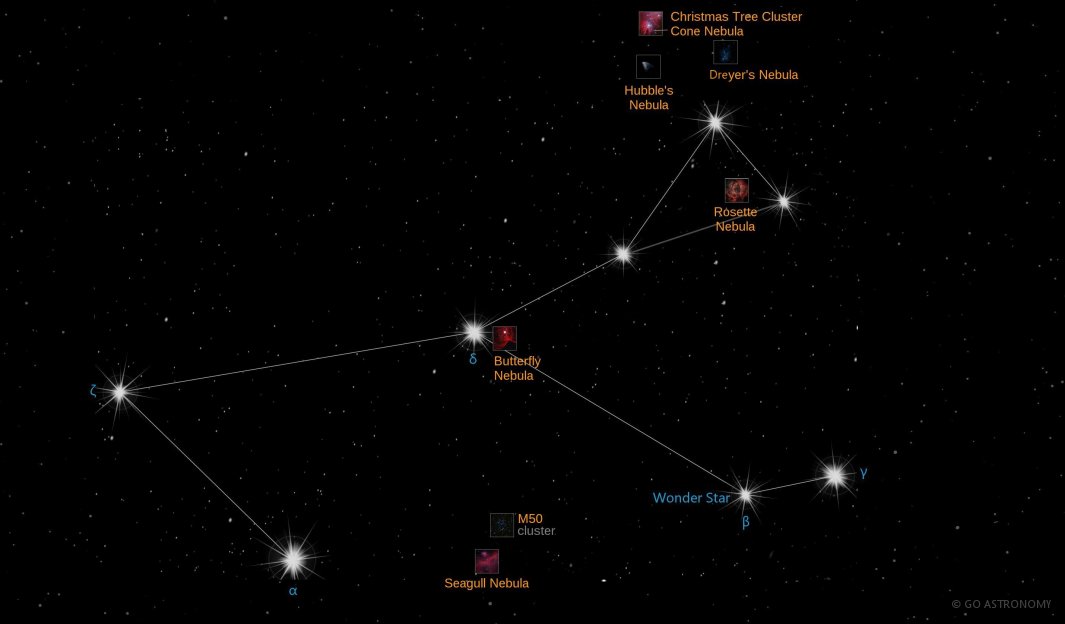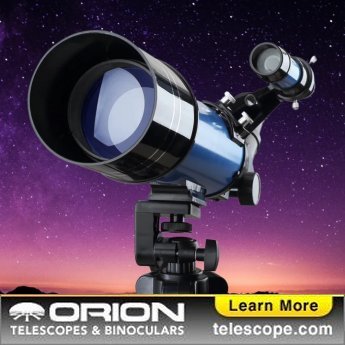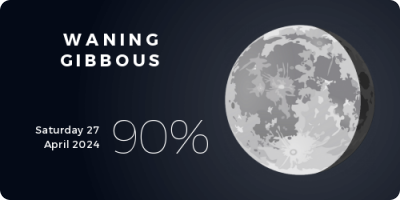Monoceros, the Unicorn (Mon)
(muh-NAH-ser-us)
The Northern constellation of Monoceros, the Unicorn, is best viewed in Winter during the month of February.
Monoceros is the 35th largest constellation. It's brightest star is Beta Monocerotis at magnitude 3.76. The boundary of the Monoceros constellation contains 14 stars that host known exoplanets.
Monoceros is an equatorial constellation, which means its bulk intersects the celestial equator or comes within 10-15 degrees of doing so. Monoceros is visible from most places on Earth.
- Pronunciation:
- muh-NAH-ser-us
- Meaning:
- Unicorn
- Genitive:
- Monocerotis
- Abbreviation:
- Mon
- Constellation Family:
- Orion
- Hemisphere:
- Northern
- Quadrant:
- NQ2
- Visibility:
- 75° N - 90° S
- Best viewing month*:
- February
- Area:
- 482 sq. degrees
- Size:
- 35th largest
- Equatorial:
- Yes
- Right Ascension (avg):
- 6h 58m
- Declination (avg):
- -1°
- Brightest star:
- Beta Monocerotis (3.76)
- Stars with planets:
- 14
- X-ray stars:
- 1 stars
- Messier objects:
- |
Brightest Stars in Monoceros
The 10 brightest stars in the constellation Monoceros by magnitude.
- Star
- Magnitude
- Spectral class
- Alpha Monocerotis (α Mon)
- 3.94
- K0III
- Gamma Monocerotis (γ Mon)
- 3.99
- K3III
- Delta Monocerotis (δ Mon)
- 4.15
- A2V
- Zeta Monocerotis (ζ Mon)
- 4.36
- G2Ib
- Epsilon Monocerotis (ε Mon)
- 4.39
- A5IV
- 13 Monocerotis (13 Mon)
- 4.47
- A0Ib
- 18 Monocerotis (18 Mon)
- 4.48
- K0III
- Beta Monocerotis (β Mon A)
- 4.6
- B3Ve
- S Monocerotis (S Mon)
- 4.66
- O7V + O9.5V
- 28 Monocerotis (28 Mon)
- 4.68
- K4III
Double Stars in Monoceros
These are the brightest and easiest-to-find double, triple, and quadruple star systems in the constellation Monoceros . Also see all star clusters.
- Star system
- Magnitudes
- Type
- Epsilon Monocerotis
- 4.4, 6.6
- double
- Beta Monocerotis
- 4.6, 5.0, 4.6, 5.4
- quadruple
Star Clusters in Monoceros
The most notable and easy-to-find star clusters in the constellation Monoceros . Also see all star clusters.
- Star cluster
- Catalog #
- Cluster type
- Cone Nebula
- open
- Messier 50
- M50
- open
- NGC 2232
- open
- NGC 2301
- open
- Satellite Cluster
- C50
- open
Nebulae in Monoceros
Notable and easy-to-find nebulae in the constellation Monoceros . Also see all nebulae.
- Nebula name
- Catalog #
- Nebula type
- Butterfly Nebula
- planetary
- Cone Nebula
- H II region
- Hubble's Variable Nebula
- C46
- reflection
- Red Rectangle Nebula
- protoplanetary
- Rosette Nebula
- C49
- H II region
- Seagull Nebula (Mon)
- emission
- Monoceros Cloud
- molecular cloud
Black Holes in Monoceros
These are the most well-known smaller (non-supermassive) black holes in the constellation Monoceros. Although black holes cannot be seen directly, the smaller ones are at the center of some star clusters and supernova remnant nebulae, which can be seen. Supermassive black holes are at the center of most galaxies, such as Sagittarius A* at the center of our Milky Way galaxy. Also see all black holes.
- Black hole
- Type
- V616 Mon
- stellar
The Unicorn of the Night Sky
Monoceros, known as the Unicorn, is a faint constellation that is positioned in the Northern Hemisphere's second quadrant (NQ2). Despite its enchanting name and mythology, this constellation is often overlooked because it is not one of the original 48 constellations described by the ancient Greek astronomer Ptolemy. Instead, it was introduced later by the Dutch astronomer Petrus Plancius in the 17th century.
Historical Overview
Monoceros is a modern constellation that doesn't have an associated mythology from ancient cultures. The constellation was first depicted by Plancius on a celestial globe in 1612. He created it from a previously undefined star field situated between the brighter constellations of Orion, Gemini, and Hydra. Monoceros Latin name means 'unicorn', which is representative of the mystical creature from European folklore.
Location and Main Features
Monoceros is situated in the second quadrant of the northern hemisphere (NQ2), and it can be observed between latitudes +75? and -90?. The constellation is bordered by Orion to the west, Gemini to the north, Hydra to the south, and Canis Major to the east. Despite its lack of bright stars, Monoceros covers a sizable area of 482 square degrees, making it the 35th largest constellation in the night sky.
Main Stars in Monoceros
The brightest star in Monoceros, Beta Monocerotis, is a triple star system, consisting of three blue-white giants. It's located approximately 700 light-years away and has an apparent magnitude of 3.76, making it a fascinating object for amateur astronomers equipped with small telescopes. Alpha Monocerotis, despite its designation, is only the fourth brightest star in the constellation with a magnitude of 3.93.
The red giant star, V838 Monocerotis, gained fame in 2002 when it temporarily increased in brightness to become 600,000 times more luminous than the Sun. The subsequent light echo produced by the star provided astronomers with one of the most stunning astronomical images of the 21st century.
Deep Sky Objects
Despite its faint stars, Monoceros is home to several notable deep-sky objects. The Rosette Nebula (NGC 2237-2246), an emission nebula with an associated star cluster (NGC 2244), is perhaps the most famous. This stunning nebula resembles a rose, hence its name, and provides an excellent target for astrophotographers.
The constellation also hosts the open star clusters NGC 2244 and NGC 2506, and the Hubble's Variable Nebula (NGC 2261), a reflection nebula associated with the variable star R Monocerotis.
Observation
Observing Monoceros can be somewhat challenging due to its faint stars. The constellation is most visible in the months of February and March for observers in the Northern Hemisphere. While none of its stars are particularly bright, its rich field of stars and deep sky objects offer a rewarding view through binoculars or a small telescope. Furthermore, its position near the ecliptic means that the Moon, planets, and the occasional comet pass within its boundaries.
* Constellation shown for northen hemisphere skies. For the southern hemisphere, constellations appear rotated 180 degrees (upside-down and left-right reversed) from what is shown. Remember that seasons are reversed too - summer in northern latitudes is winter in southern latitudes.
** Circumpolar constellations are visible year-round in the hemisphere listed (and not at all in the opposite hemisphere).





